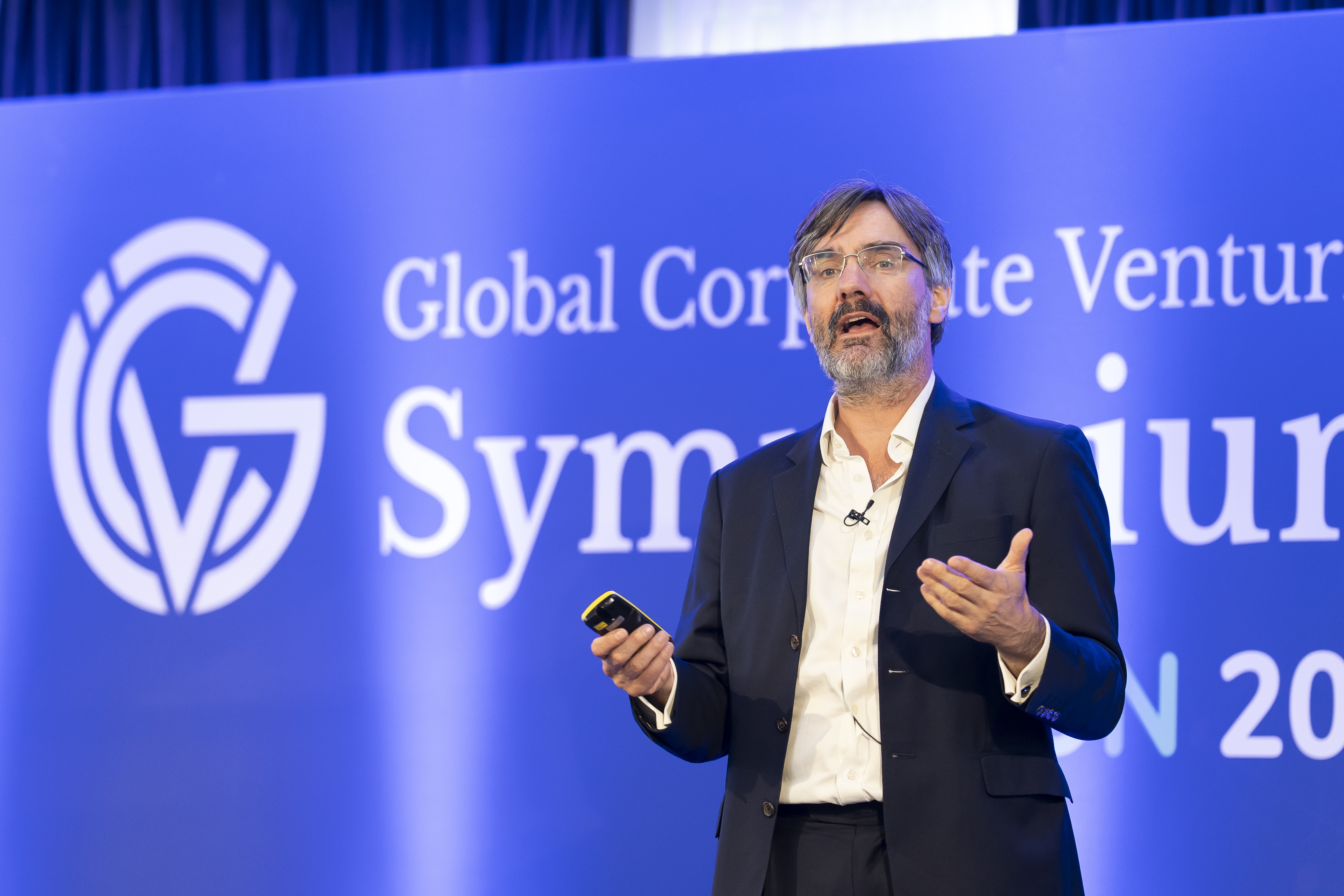The importance of corporate venturing is growing for governments and startup ecosystems. But the industry is still looking for the optimal model.

Corporate investors have never been more crucial to the innovation ecosystem, with governments, universities and startups all increasingly keen to attract and partner with them. But at the same time, the corporate venture sector is facing a time of transition as companies try to work out how best to benefit from their innovation arms.
These were some of the themes that emerged most clearly during the GCV Symposium in London, a conference that attracted more than 350 attendees from the corporate venture industry to the UK capital last week.
Governments are courting corporate investors
Corporate investment is seen as more important than ever by governments, with Poppy Gustafsson, UK minister of state for investment, urging corporates to increase their involvement in the country’s startup ecosystem. Baroness Gustafsson promised government support in the form of helping corporates navigate the complexities of government.
Ursel Velve, chairman of the management board of Enterprise Estonia, meanwhile, was at the Symposium to make the case for corporations using the Baltic state as a testing and innovation ground. Estonia is rolling out a unique sandboxing concept where companies wanting to test out a new technology can for a period of time, obtain exemptions to any restrictive legislation. This is being tried, for example, in testing out automated kiosks dispensing pharmaceuticals.
Universities are also eager to partner
The UK academic sector is also eager to partner with corporate investors, and university-affiliated investment organisations are making such collaboration easier. Representatives from spinout investment firms such as Oxford Science Enterprises (OSE), Cambridge Innovation Capital and Northern Gritstone pitched the opportunities for corporates to co-invest or take limited partner positions in their firms’ investment portfolios.
OSE is seeking to double the number of spinouts it creates a year to 20 from around 10 today. The investment company has 75 shareholders including some corporates such as Google. OSE has invested £2.5bn in its portfolio over the past 10 years. Last week, it announced its first unicorn exit when it sold quantum computing spinout Oxford Ionics to US company IONQ for $1.1bn. The investor has several spinouts where corporates are co-investors, but it wants to attract more investment from the CVC sector.
“We feel we are just scraping the surface of the CVC opportunity for your benefit and also from ours,” said Ed Bussey, CEO of OSE.
CVCs are in search of the right model
But, even as they are being courted, corporate investment teams themselves are facing a time of transition. Higher interest rates and economic uncertainty have made it hard for startups to achieve stock market listings in the past three years, and exits overall are down. CVC units have faced searching questions from corporate leaders about their value and efficiency. Where once corporate investment arms might have been set up to look like regular VC firms, now companies are increasingly modifying that model to serve their individual needs.
As Amy Burr, of JetBlue Ventures puts it: “CVC can be whatever an individual organisation needs it to be.”
Centralised or decentralised CVC?
We heard from two heads of strategy — Kemal Ramdani, chief technology and innovation officer at GC, the Thai petrochemicals company, and Anton Kotov, head of corporate strategy and M&A at technology company ABB— who have shifted the way corporate investment operates in their companies, albeit in opposite ways.
GC has centralised the team and made it more clearly strategic in focus, while ABB decentralised the investment function so that it now rests with the three business divisions. This, Kotov said, has dramatically increased the rate at which portfolio companies collaborate with the business.
The services-for-equity model
Another theme was having corporate venture operate with less cash but on more of a service-exchange basis. One model for this could come from media-for-equity. Vinay Solanki, head of Channel 4 Ventures, Niko Waesche, founding partner of GMPVC German Media Pool and Piyush Puri, founding partner, of Mercurius Media Capital, explained how their model could be the baseline for a services-for-equity model.
Startups could get cloud services, manufacturing, logistics and many other crucial but specialised services from corporates in lieu of capital. That might be especially appealing at a time when corporates are looking to cut spending.
Adding venture building to the mix
Venture building, when companies found and grow their own internal startups, is also becoming a tool large corporations are keen to explore.
“New business building is becoming a very priority for CEOs because one of the concerns for organisations is if they don’t transform and change their core business, they will be at risk in the next five to 10 years,” said Gurdeep Singh Kohli, who helped set up a large scale venture building operation, SC Ventures, for Standard Chartered bank.
VC-style funds that can survive long term
If a corporation still wants to follow a classic VC-style investment strategy, this can still be a powerful tool. George Kellerman, founding managing partner of Toyota’s growth fund Woven Capital, says a fund like this can bring in new perspectives and push corporations to consider technology areas they would not normally see.
In order for such a unit to have the longevity to last through at least a full investment cycle of 10-12 years, it is important to set it up correctly, Kellerman says. Based on his experiences of setting up a CVC arm for Yamaha Motor Ventures and now at Toyota, he shared six tips for setting up a fund that could survive changes in leadership or focus at the parent company. Key points include having a dedicated fund and an externally hired team, alongside robust mechanisms to foster partnerships between portfolio companies and the corporate.
Spinning out the unit to serve multiple companies
When it no longer makes sense for a corporate to run a CVC arm, one of the options is to spin out the unit, often still maintaining some links in the form of financial backing. A recent example of how this can be done is JetBlue Ventures, which was acquired by aircraft leasing firm Sky Leasing last month.
Burr, chief executive, explained how the relationship is evolving, with JetBlue Ventures now looking to also raise money from and advise a range of other corporations.
Beyond the fundamentals of models, here are some of the other debates that corporate investors were having.
Investing at the early stage or late stage?
With corporations now more eager to realise strategic benefits from startup investments, should corporate investors move away from early-stage investment?
Bernhard Mohr, managing partner at Evonik Venture Capital, said that in the chemicals industry, early-stage companies take a long time to develop and trying to explain a write off to corporates who do not like failure is a challenge. To mitigate these risks, Evonik itself makes direct investments at the later stage and only participates in early stage rounds through its LP positions in early-stage funds.
Terry Doyle, managing partner of Telus Ventures, agreed that a big company doing a deal with a small 10-person team can be very challenging, and often there was a preference for corporates to back startups that already have somewhere between $5-10m in annual recurring revenue. However, Telus Ventures would go in at an earlier stage to support a startup in an underinvested segment like women’s health.
Cooperation agreements are also easier with larger companies, resulting in nearly 90% of Evonik Venture Capital’s portfolio companies having collaborations with the parent company – something that’s also easier to do with mature startups. Telus, for its part, did $34m of business with Telus Ventures portfolio companies last year.
Time horizons have lengthened — both for startup runways and investment cycles
Mohr also said that investors need to be looking for longer runways today than in the past – whereas once 18-24 months worth of funding was enough for a startup, now they should have 30-36 months.
Romy Schnelle, managing director of High-Tech Gründerfonds, said that staying power is the most important thing for startups today, and investors need to think 15-20 years ahead, not just seven-10.
It’s not CVC vs VC, but value-add vs non-value-add investors
Corporate investors and institutional VCs have a long history of collaborating, and arguably the value-added benefits that a corporate partner can bring are more important than ever. On a panel discussion about collaboration between VCs and CVCs, T.Capital principal Joshua Muller emphasised the importance of everyone in the syndicate knowing their place and their specific value.
Cash alone, as the panellists agreed, is now a commodified resource. GFT Ventures co-founding managing partner Jay Eum said that collaboration is less defined by VCs or CVCs, than it is by value-add or non-value-add investors. Even among CVCs who in theory bring in corporate value, there are those units that pull out all the stops, and those who don’t even facilitate connections with their parent company.
Smaller CVC unit’s like JLR’s InMotion Ventures have to work even harder to bring and communicate that value-add, said unit chief Mike Smeed, who added that 100% of portfolio companies from their second fund now have a collaboration in place with the parent company. Action, in this sense, speaks louder than words.
“Nothing beats doing it rather than just talking about it,” said Smeed.
Investment themes:
Some of the key themes for investors at the conference included mobility, defence, energy and healthcare.
How to invest in the automotive sector as cars become “computers on wheels”
Right now a car is not an asset for owners, says Nicole LeBlanc, partner at Toyota’s Growth Fund Woven Capital. “It’s something that you have to have. It depreciates over time, and then you can hopefully sell it for a half decent price on the other end. But they’re becoming these computers on wheels which can be potential energy sources to power your home, for example. So, it’s all going to change completely in the next five to 10 years.”
Ben Lawson, vice president of strategic initiatives Europe at Enterprise Mobility Ventures, said the vehicle rental company was already seeing completely new types of demands from customers.
“They wanted a large engine in the past, but today, one of the most common questions when enquiring about a car is, ‘does it have an Android system or does it connect to Apple CarPlay? Or what sort of software am I going to be able to link to in that vehicle?”
In a roundtable discussion about mobility and the future of transportation, speakers explored the emerging opportunities of software-defined vehicles — the ones that manage their operations, add functionality and enables new features primarily through software.
Woven Capital is responding by transitioning from a mobility company to a data company, while Enterprise Mobility Ventures is looking at ways it can influence the automotive software roadmap to benefit fleet operators.
Energy transition
Discussions around the energy transition looked at areas like data centres and AI, but also turned to the area of grid resilience in the wake of the big power outages in the Iberian peninsula in April.
“I think it’s the elephant in the room…the reality is, the grid is end of life,” said Nicola Bates, head of Boeing venturing arm XeleratedFifty. “This isn’t just a green reality, this is a practical reality of the infrastructure. Then we get into the resilience perspective, the national security perspective of what if it does all start to crumble? What is an alternative going to look like?”
Defence
Investors in defence-related startups acknowledged the vast uptick in interest in this sector since Russia’s attack on Ukraine.
“We’re seeing a big shift here in Europe on what is dual use and what isn’t dual use,” said Clayton Williams, managing director of In-Q-Tel, a venture capital firm that invests on behalf of the US intelligence community. European investors had previously been wary of investing in solely military use technologies, preferring to look at technologies that also had civilian applications. But these definitions are shifting.
Williams said there had also been a stark learning for startups supplying technology to the Ukraine conflict.
“In Ukraine, at the beginning of the conflict our robotics companies just kind of dropped a bunch of equipment off at the border and said ‘good luck’ and frankly those all failed because they may be all very novel platforms but if it has a non-resilient communications backhaul it fails regardless of how excellent it may be otherwise. That was a big lesson learned for all western innovators, that you have to actually be involved in the theatre, and understand how [the technology] is used,” he said.

Maija Palmer
Maija Palmer is editor of Global Venturing and puts together the weekly email newsletter (sign up here for free).







